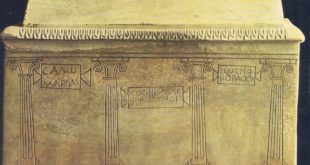UNDER THE Omayyads, who ruled from 661 to 750, Islam had grown into a mighty empire. Arabic had become its language, while the Arabs, in turn, had picked up useful skills from the peoples they had conquered. The state had grown rich from the tribute paid by non-Moslems and the land tax paid by landowners. Though the caliphs were mainly concerned with pleasure and power, they had not neglected religion completely. They had built the Dome of the Rock in Jerusalem and the Omayyad Mosque in Damascus — two magnificent sanctuaries which were the holiest places in Islam after the Kaaba and the Medina mosque. The believers had become divided, as they would remain divided, into Sunnites and Shiites.
Now it was the turn of the Abbasids, who were to rule over the eastern part of the Arab Empire from 750 to 1258. Their first century of power was the Golden Age of Islam. Of all thirty-seven Abbassid caliphs, three stand out above the rest: al-Mansur, Harun al-Raschid and al-Mamun.
Although he reigned after his brother the Bloodshedder, al-Mansur (754-775) was the real founder of the dynasty. It was he who firmly established it in power. He crushed a rebellion of Shiites. He raided the border strongholds of the Byzantines. He appointed the first vizier, or chief advisor. This practice, copied from the courts of the Persian emperors, was carried on by all the caliphs who came after him.
BAGHDAD AND ITS RULERS
Al-Mansur’s greatest achievement was building Baghdad, the fabled city of The Arabian Nights. He himself chose the site on the banks of the Tigris. Constructed in four years by a hundred thousand architects and workmen, Baghdad became the imperial capital of the Abbasids. It also became one of the greatest centres of trade in the world. To its open-air markets or bazaars, by caravan and ship, came cargoes of Silk and porcelain from China, spices and dyes from India, rubies, precious stones and fine cloth from the Turkish lands of central Asia, honey, furs and slaves from Russia and Scandinavia, ivory, gold dust and slaves from east Africa. The products of the empire’s farflung provinces also flowed into Baghdad. Soon, al-Mansur’s city was tremendously wealthy. For centuries, no other city could match its magnificence, except, perhaps, the Byzantine capital, Constantinople.

Al-Mansur’s grandson, Harun al-Raschid, who was caliph from 786 to 809, is remembered in Europe as the great friend and ally of Charlemagne. European histories tell of an exchange of costly gifts between the two rulers. To Moslems, Harun’s friendship with the Christian emperor of the Franks is unimportant. They remember him, first of all, as the greatest ruler in their history. Even during his lifetime, many stories were told about his wise sayings and clever deeds. After his death, these stories multiplied. Yet none of the stories about him are so well known as those that were supposed to have been told to him. For Harun was the caliph in The Arabian Nights. It was he whom the slave girl Scheherezade kept enthralled for a thousand and one nights with her thrilling tales of adventure and romance.

Harun believed strongly in learning. He summoned scholars to his court and paid them well. They translated into Arabic, books that had been written in Greek and Persian, in the Syrian language called Syriac and in Sanskrit, the language of the Aryan people of northwest India. Harun was also interested in the learning and arts of his own time. To his majestic palace in Baghdad he invited poets, philosophers, and scientists. Musicians, dancers, magicians, tumblers, acrobats and other entertainers were welcomed, too, for the pleasure they gave him and his guests.
Meanwhile, Harun energetically carried on the holy war against the Byzantines. In 806, his armies took several cities in Asia Minor. This victory brought him particular satisfaction, for it enabled him to humiliate his enemy, the Christian emperor, by making him pay a stiff personal tax.

When Harun died, his son al-Amin, became caliph. Four years later, al-Amin’s younger brother al-Mamun seized the throne. Al-Mamun’s reign (815-833) was as glorious as his father’s. Never since the greatest days of the Roman Empire had a ruler lived in such luxury. When, in 825, the aging caliph married his vizier’s eighteen-year-old daughter, a thousand huge pearls were said to have been showered on the couple. Balls of perfumed wax, containing tickets which entitled the holders to estates and slaves, were casually tossed out among the guests. Al-Mamun was interested in more than pleasure and luxury. Like Harun, he welcomed men of talent to his court and paid them handsomely for their work.
After al-Mamun, court life went on in the same way. In time, the years of luxury began to have their effect. The caliphs were feeble men who had to spend their days protecting themselves against the plots of their innumerable half brothers, instead of governing. Weaknesses within the court were matched by weaknesses throughout the empire. Discontent steadily rose over the way the government favored Arabs over non-Arabs, Arab Moslems over other Moslems and Moslems over non-Moslems. The believers split into more and still more sects, Sunnite and Shiite.
As caliph‚ al-Mamun had held more power than any ruler on earth. Only a hundred years later, the man who was now caliph could not be sure his orders would be obeyed even within the capital. Nevertheless, a kind of magic continued to cling to the Abbasid name. Although the Abbasids’ enemies were often strong, they never united against them. More than four centuries after Mamun’s death, a caliph of the house of Abbas was still sitting on the throne of Baghdad. The blow that toppled him from that throne came not from within his divided empire, but from outside it.




